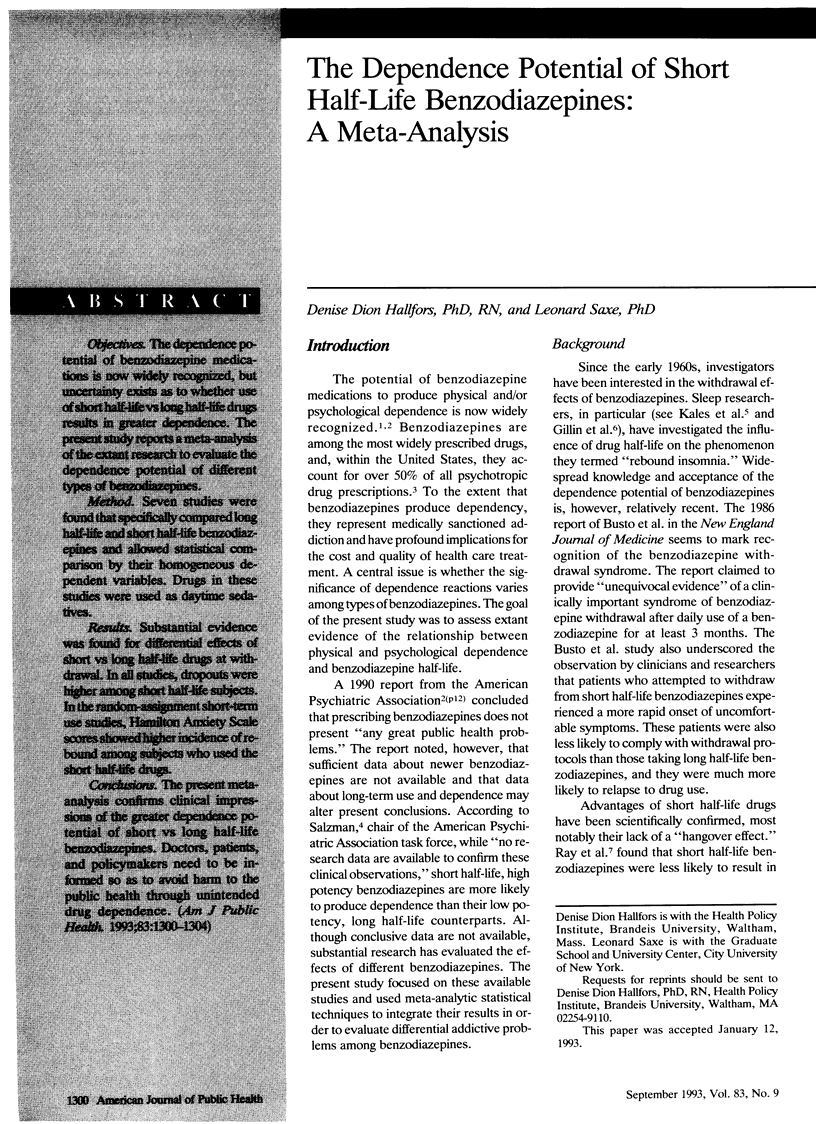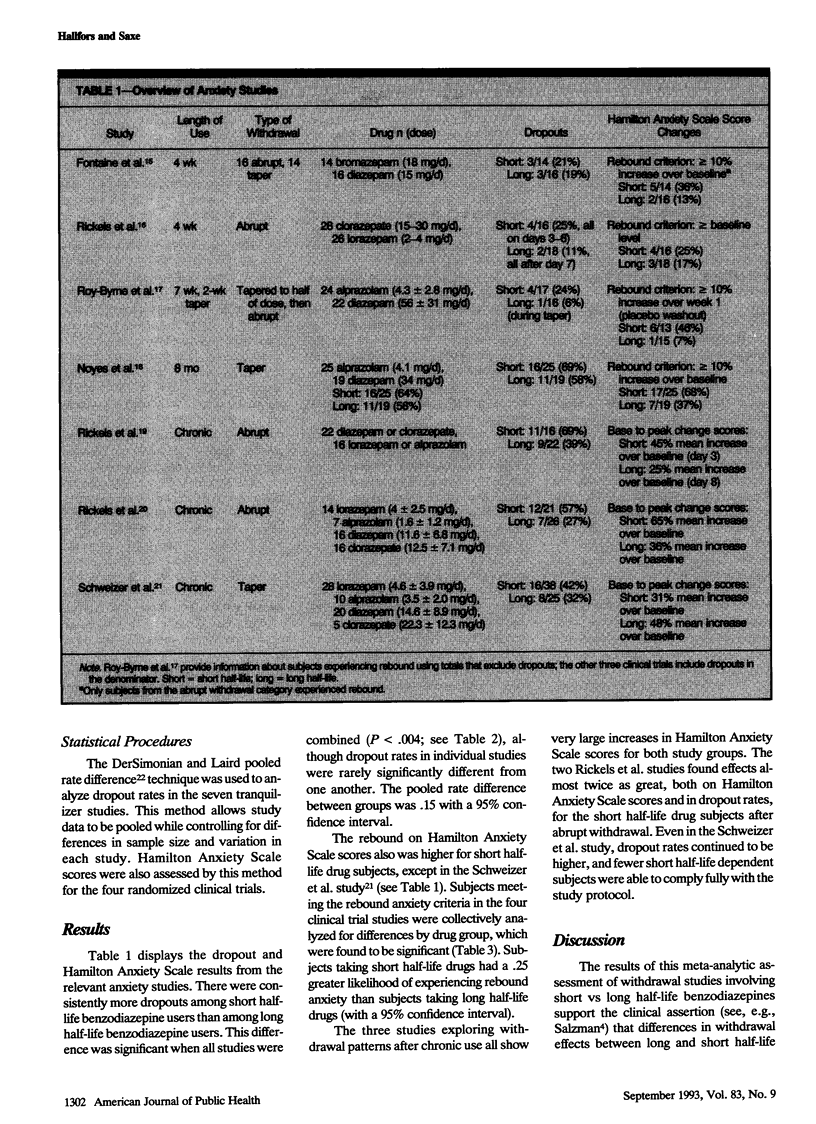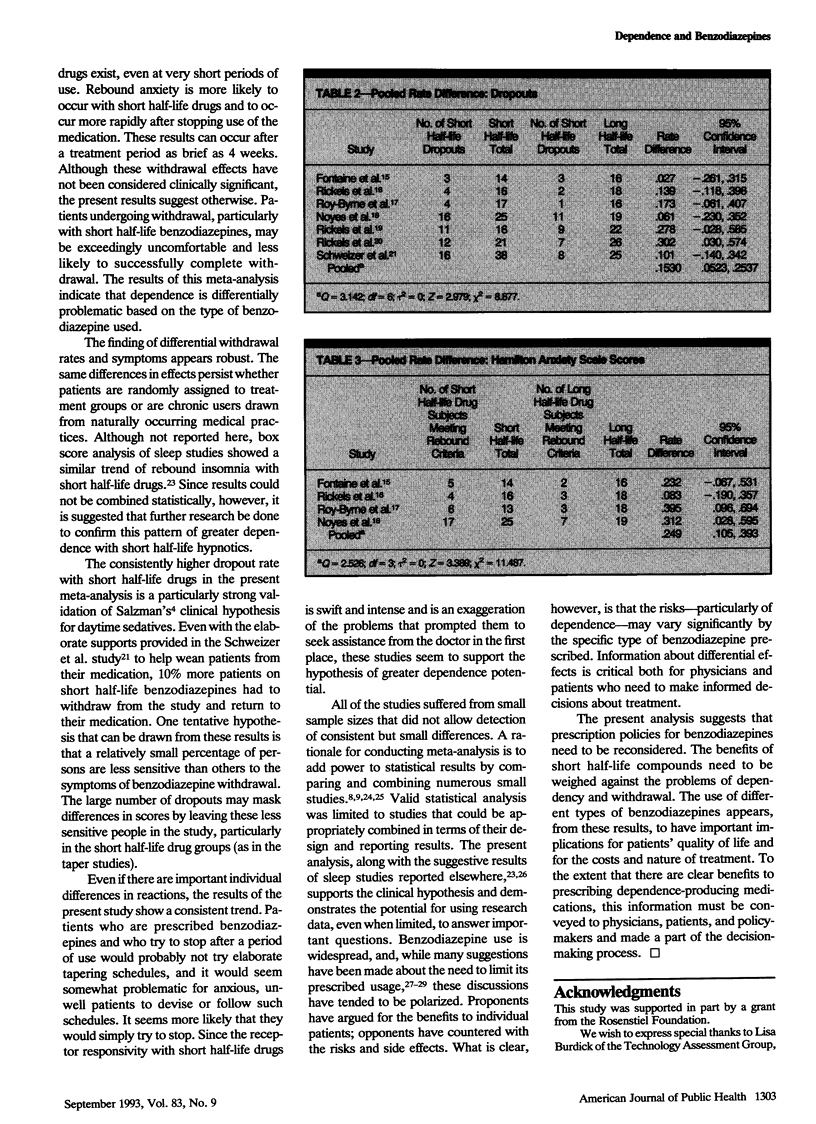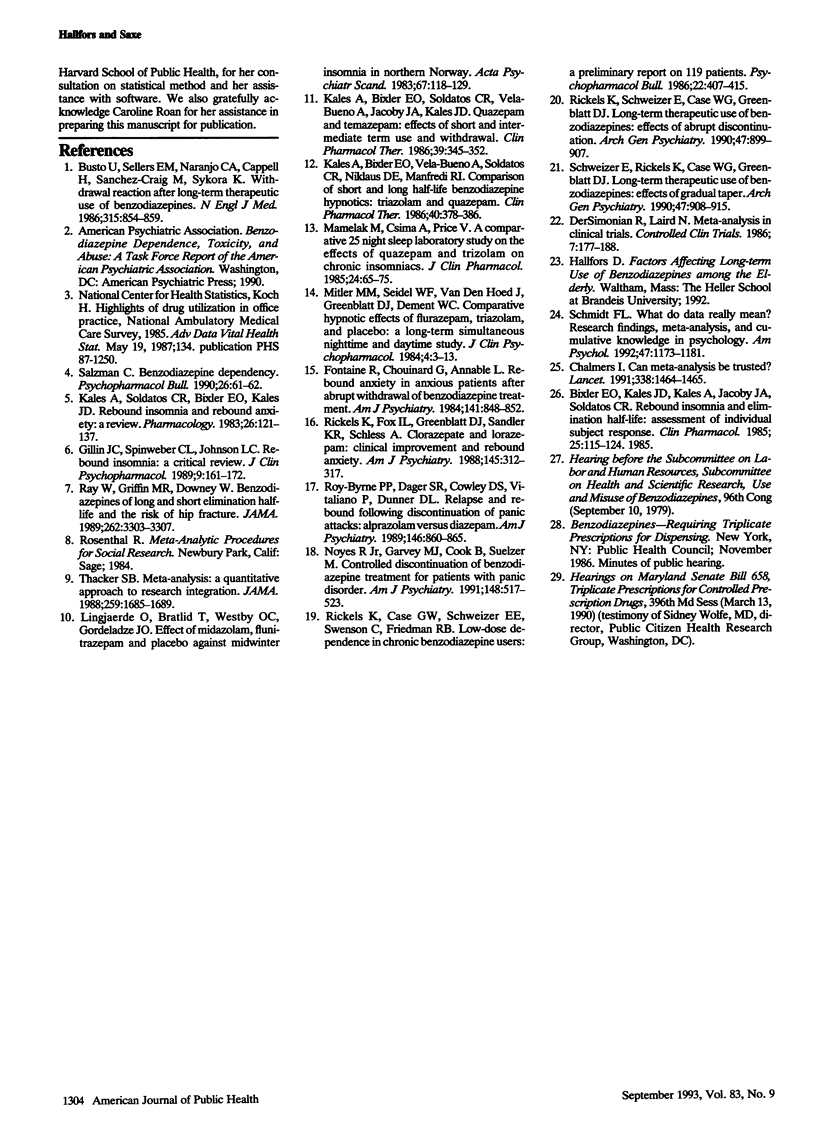Abstract
OBJECTIVES. The dependence potential of benzodiazepine medications is now widely recognized, but uncertainty exists as to whether use of short half-life vs long half-life drugs results in greater dependence. The present study reports a meta-analysis of the extant research to evaluate the dependence potential of different types of benzodiazepines. METHOD. Seven studies were found that specifically compared long half-life and short half-life benzodiazepines and allowed statistical comparison by their homogeneous dependent variables. Drugs in these studies were used as daytime sedatives. RESULTS. Substantial evidence was found for differential effects of short vs long half-life drugs at withdrawal. In all studies, dropouts were higher among short half-life subjects. In the random-assignment short-term use studies, Hamilton Anxiety Scale scores showed higher incidence of rebound among subjects who used the short half-life drugs. CONCLUSIONS. The present meta-analysis confirms clinical impressions of the greater dependence potential of short vs long half-life benzodiazepines. Doctors, patients, and policymakers need to be informed so as to avoid harm to the public health through unintended drug dependence.
Full text
PDF




Selected References
These references are in PubMed. This may not be the complete list of references from this article.
- Bixler E. O., Kales J. D., Kales A., Jacoby J. A., Soldatos C. R. Rebound insomnia and elimination half-life: assessment of individual subject response. J Clin Pharmacol. 1985 Mar;25(2):115–124. doi: 10.1002/j.1552-4604.1985.tb02811.x. [DOI] [PubMed] [Google Scholar]
- Busto U., Sellers E. M., Naranjo C. A., Cappell H., Sanchez-Craig M., Sykora K. Withdrawal reaction after long-term therapeutic use of benzodiazepines. N Engl J Med. 1986 Oct 2;315(14):854–859. doi: 10.1056/NEJM198610023151403. [DOI] [PubMed] [Google Scholar]
- DerSimonian R., Laird N. Meta-analysis in clinical trials. Control Clin Trials. 1986 Sep;7(3):177–188. doi: 10.1016/0197-2456(86)90046-2. [DOI] [PubMed] [Google Scholar]
- Fontaine R., Chouinard G., Annable L. Rebound anxiety in anxious patients after abrupt withdrawal of benzodiazepine treatment. Am J Psychiatry. 1984 Jul;141(7):848–852. doi: 10.1176/ajp.141.7.848. [DOI] [PubMed] [Google Scholar]
- Gillin J. C., Spinweber C. L., Johnson L. C. Rebound insomnia: a critical review. J Clin Psychopharmacol. 1989 Jun;9(3):161–172. [PubMed] [Google Scholar]
- Kales A., Bixler E. O., Soldatos C. R., Vela-Bueno A., Jacoby J. A., Kales J. D. Quazepam and temazepam: effects of short- and intermediate-term use and withdrawal. Clin Pharmacol Ther. 1986 Mar;39(3):345–352. doi: 10.1038/clpt.1986.51. [DOI] [PubMed] [Google Scholar]
- Kales A., Bixler E. O., Vela-Bueno A., Soldatos C. R., Niklaus D. E., Manfredi R. L. Comparison of short and long half-life benzodiazepine hypnotics: triazolam and quazepam. Clin Pharmacol Ther. 1986 Oct;40(4):378–386. doi: 10.1038/clpt.1986.194. [DOI] [PubMed] [Google Scholar]
- Kales A., Soldatos C. R., Bixler E. O., Kales J. D. Rebound insomnia and rebound anxiety: a review. Pharmacology. 1983;26(3):121–137. doi: 10.1159/000137794. [DOI] [PubMed] [Google Scholar]
- Lingjaerde O., Bratlid T., Westby O. C., Gordeladze J. O. Effect of midazolam, flunitrazepam, and placebo against midwinter insomnia in northern Norway. Acta Psychiatr Scand. 1983 Feb;67(2):118–129. doi: 10.1111/j.1600-0447.1983.tb06731.x. [DOI] [PubMed] [Google Scholar]
- Mamelak M., Csima A., Price V. A comparative 25-night sleep laboratory study on the effects of quazepam and triazolam on chronic insomniacs. J Clin Pharmacol. 1984 Feb-Mar;24(2-3):65–75. doi: 10.1002/j.1552-4604.1984.tb02767.x. [DOI] [PubMed] [Google Scholar]
- Mitler M. M., Seidel W. F., van den Hoed J., Greenblatt D. J., Dement W. C. Comparative hypnotic effects of flurazepam, triazolam, and placebo: a long-term simultaneous nighttime and daytime study. J Clin Psychopharmacol. 1984 Feb;4(1):2–13. [PubMed] [Google Scholar]
- Noyes R., Jr, Garvey M. J., Cook B., Suelzer M. Controlled discontinuation of benzodiazepine treatment for patients with panic disorder. Am J Psychiatry. 1991 Apr;148(4):517–523. doi: 10.1176/ajp.148.4.517. [DOI] [PubMed] [Google Scholar]
- Ray W. A., Griffin M. R., Downey W. Benzodiazepines of long and short elimination half-life and the risk of hip fracture. JAMA. 1989 Dec 15;262(23):3303–3307. [PubMed] [Google Scholar]
- Rickels K., Case W. G., Schweizer E. E., Swenson C., Fridman R. B. Low-dose dependence in chronic benzodiazepine users: a preliminary report on 119 patients. Psychopharmacol Bull. 1986;22(2):407–415. [PubMed] [Google Scholar]
- Rickels K., Fox I. L., Greenblatt D. J., Sandler K. R., Schless A. Clorazepate and lorazepam: clinical improvement and rebound anxiety. Am J Psychiatry. 1988 Mar;145(3):312–317. doi: 10.1176/ajp.145.3.312. [DOI] [PubMed] [Google Scholar]
- Rickels K., Schweizer E., Case W. G., Greenblatt D. J. Long-term therapeutic use of benzodiazepines. I. Effects of abrupt discontinuation. Arch Gen Psychiatry. 1990 Oct;47(10):899–907. doi: 10.1001/archpsyc.1990.01810220015002. [DOI] [PubMed] [Google Scholar]
- Schweizer E., Rickels K., Case W. G., Greenblatt D. J. Long-term therapeutic use of benzodiazepines. II. Effects of gradual taper. Arch Gen Psychiatry. 1990 Oct;47(10):908–915. doi: 10.1001/archpsyc.1990.01810220024003. [DOI] [PubMed] [Google Scholar]
- Thacker S. B. Meta-analysis. A quantitative approach to research integration. JAMA. 1988 Mar 18;259(11):1685–1689. doi: 10.1001/jama.259.11.1685. [DOI] [PubMed] [Google Scholar]


